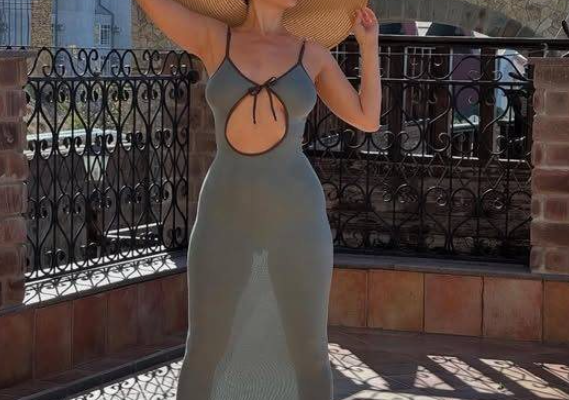The Truth Behind the “Thigh Gap” and What It Really Means
In recent years, the term “thigh gap”—referring to the space between a woman’s upper thighs when standing with her feet together—has gained attention on social media, often presented as an ideal of beauty or femininity. Yet this so-called “separation” between a woman’s legs doesn’t reveal anything about her worth, attractiveness, or health. It’s time to unpack the truth behind this viral obsession and understand why body diversity deserves celebration instead of comparison.
A Social Media Myth
The thigh gap trend rose to prominence in the early 2010s, especially on platforms like Tumblr, Instagram, and TikTok. Influencers, models, and fitness accounts showcased images that seemed to suggest a visible gap between the thighs was a sign of being slim, fit, or beautiful. For millions of young women, this trend became a symbol of perfection. Unfortunately, it also became a source of insecurity and unhealthy behavior.
However, what most people fail to recognize is that the existence of a thigh gap has little to do with one’s fitness level or effort—it’s primarily determined by bone structure. The width of a woman’s hips, the shape of her pelvis, and how her femur (thigh bone) connects to her pelvis are genetic factors. No diet or workout can change that anatomy. In short: the “gap” is not a reflection of health or beauty—it’s a reflection of bone geometry.
The Biology Behind Body Shapes
Women’s bodies come in countless shapes—pear, apple, hourglass, rectangle—and all are normal. The shape and spacing of the thighs depend on the way the hips are aligned and how fat and muscle are distributed. Some women naturally have a visible space between their thighs, while others do not, even if they are extremely fit and maintain a healthy lifestyle.
For example, a woman with wider-set hips might have a gap even if she carries more body fat, while someone with narrow hips and muscular thighs might have no gap at all. Neither body type is “better”—they’re simply different.
It’s essential to understand that fitness and health cannot be measured by appearance. Doctors and health experts assess health through strength, stamina, blood pressure, cardiovascular fitness, and mental well-being—not by the distance between someone’s legs.
The Psychological Toll of Unrealistic Standards
The fetishization of the thigh gap has contributed to a dangerous culture of comparison and body shame. Young women, influenced by filtered images, often chase an unrealistic version of themselves. This can lead to eating disorders, anxiety, and body dysmorphia.
According to mental health professionals, the constant exposure to “ideal” body images online rewires the brain to associate thinness with value. This distorted view pushes many into unhealthy diets and obsessive fitness regimens. Studies show that nearly 70% of teenage girls report dissatisfaction with their bodies—many citing social media as the main reason.
But when women learn that the thigh gap is largely determined by anatomy, not effort, they can begin to free themselves from the harmful narrative that they must look a certain way to be considered beautiful.
The Role of Media and Advertising
Mainstream fashion and advertising have long perpetuated narrow definitions of beauty. From glossy magazine covers to runway models, thinness has often been marketed as the ultimate goal. But times are changing. Campaigns like Dove’s Real Beauty and Aerie’s #AerieREAL have encouraged body positivity by featuring unretouched photos of women with diverse body types.
Social media has also seen a shift, with many creators promoting body neutrality—the idea that your body doesn’t have to be beautiful to be valuable. It’s not about loving every part of yourself every day; it’s about recognizing that your worth isn’t tied to your appearance.
Health Over Aesthetics
Chasing a thigh gap can lead to dangerous habits like extreme calorie restriction, dehydration, and over-exercising. These practices can harm metabolism, weaken bones, and disrupt hormonal balance. In contrast, a balanced lifestyle—regular physical activity, nourishing food, proper rest, and self-compassion—leads to lasting health and confidence.
True wellness comes from respecting your body’s needs, not punishing it to fit into an internet trend. Strength, endurance, flexibility, and mental calm are far more meaningful than any visible space between one’s thighs.
Cultural Shifts and Empowerment
Different cultures have celebrated different body types throughout history. In some eras, fuller figures were considered symbols of fertility and prosperity; in others, athletic builds were admired. The “ideal” body has never been fixed—it changes with society’s values and media influence.
Today’s movement toward body acceptance is about rejecting those arbitrary standards. Women around the world are redefining beauty to include authenticity, confidence, and individuality. The more we see real, unfiltered images, the more we understand that beauty is not a single mold—it’s a spectrum.
Embracing Body Diversity
Every woman’s body tells a story—of genetics, lifestyle, culture, and experiences. Celebrating that diversity means accepting that no single trait defines beauty. The separation between a woman’s legs doesn’t indicate anything about her desirability, success, or strength. What truly matters is how she feels in her own skin, how she treats others, and how she lives her life.
When we stop reducing women to body parts and start valuing their character, intelligence, and compassion, society becomes healthier as a whole.
The New Message
So the next time someone suggests that a thigh gap—or any physical feature—defines beauty or worth, remember this truth: your body is not a trend. What social media glorifies today may fade tomorrow, but your self-respect, health, and individuality will never go out of style.
The space between a woman’s legs means nothing more than the space between her bones. What truly separates a confident woman from the rest is not anatomy—it’s her mindset, her resilience, and her ability to rise above shallow definitions of beauty.


